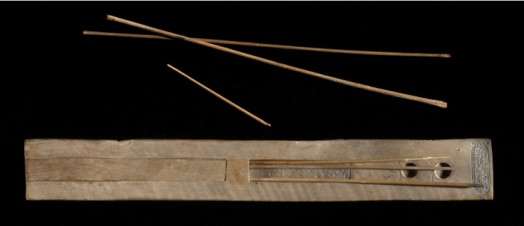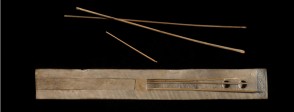
What is this, and who used it?
Wooden palettes like this were used by Egyptian scribes in their daily work. This typical example belonged to a high-ranking scribe called Pamerihu. It has a central slot to hold reed pens and two recesses at the top to hold cakes of solid black and red ink. Black ink was made from soot mixed with gum and was used for writing the main part of texts. Red ink was made from gum and ochre, a kind of earth rich in iron oxide; it was used for headings and titles. Above the ink pans is the cartouche of Amenhotep III, suggesting that Pamerihu may have worked at the royal court.
The development of writing
Following the unification of the Nile Valley and Delta into a single Egyptian kingdom around 3100 BC, the establishment of a central administration created an urgent need for an efficient writing system that would allow Egypt’s rulers to communicate over long distances. Scribes were already using simple pictograms and ideograms and had begun to use the sound values of these signs to write names. The same principle was now applied to other words, which made it possible to express abstract ideas. Vowels were omitted when writing to save time and space. The original characters, hieroglyphs, were very detailed and time-consuming to draw, and were soon confined to religious inscriptions. Instead, a more flowing script, hieratic, was adopted for everyday use. This in turn was replaced by the even faster demotic script. Papyrus, made from the stems of a water plant, was expensive and normally only used for writing important documents. Most everyday documents were written on scraps of pottery, wood or stone.
The civil service
Governing Egypt was a highly complex task. The king and his deputy ruled the country via a hierarchy of civil servants, regional governors, local officials and administrators, who collected and distributed national resources and supplies. This made it essential to have a system of record-keeping, communication and measurement. The Egyptians did not use money, so taxes were collected and wages paid in goods. Agricultural work and building projects required workers to be recruited, fed and supplied with tools and materials, while maintaining the army meant housing, arming and provisioning the troops. In order to do their jobs, the owners of these palettes also needed a high level of numeracy and a sound knowledge of practical mathematics.
Education
Egypt’s administrators came from the privileged one per cent of the population who received a formal education. This was reserved for boys, usually from wealthy families, as a scribal education opened the way to a prestigious career. Most other boys followed their family’s trade, learning by working alongside their fathers and older male relatives. Girls stayed at home with the women, learning domestic tasks to prepare them for their future roles as wives and mothers.
Boys who received a formal education were taught to read and write on wooden boards, which could be wiped clean. Their teachers wrote corrections in the margins, just as they do today. Most writing exercises involved copying texts giving advice on proper behaviour or samples of the documents they would be producing in their work, such as letters. They would also practise mathematical exercises. Discipline was strict, with beating the usual punishment.
Around the age of ten, a schoolboy would start work as the apprentice to a senior scribe. From then on, he would study the specialist skills required by his job, such as accounting and record keeping for the civil service, theology and astronomy for the priesthood, logistics for the armed forces and geography and foreign languages for the diplomatic service.
More information
The palette of Pamerihu
http://www.britishmuseum.org/research/collection_online/collection_object_details.aspx?objectId=118223&partId=1&searchText=scribal+palette&images=true&page=1
Introduction to Egyptian language and writing
http://www.britishmuseum.org/explore/highlights/article_index/l/language_in_ancient_egypt.aspx
Outline of ancient Egyptian scripts and writing, and scribal materials
http://wordinfo.info/unit/2655?letter=a&spage=1&s=scribe
Discussion of education and apprenticeship in ancient Egypt
With extracts from instructional texts.
http://escholarship.org/uc/item/1026h44g#page-1
Description of education and literacy in the ancient Egyptian community of Deir el-Medina
http://www.scientificamerican.com/article/daily-life-in-ancient-egypt-2005-01/
A History of the World in 100 objects from the BBC : the Rhind Mathematical Papyrus
Illustrates the importance of literacy and numeracy in ancient Egypt. Listen to the programme or read the transcript.
http://www.bbc.co.uk/ahistoryoftheworld/objects/y1T3knf-T66RwWyEt_cZBw
Outline of the structure of ancient Egyptian government
http://www.touregypt.net/featurestories/government.htm
A History of the World in 100 objects from the BBC: the Rosetta Stone
Illustrates the Rosetta Stone's importance in deciphering hieroglyphs and unlocking the ancient Egyptian language. Listen to the programme or read the transcript.
http://www.bbc.co.uk/ahistoryoftheworld/objects/awwjbIoORUaQXm9LmiTz8A
Article on hieroglyphs and their decipherment
http://www.bbc.co.uk/history/ancient/egyptians/decipherment_01.shtml
Pocket guide to ancient Egyptian hieroglyphs by Richard Parkinson
http://www.britishmuseumshoponline.org/invt/cmc30071/?ref=searchzone
Write your own hieroglyphs by Angela McDonald
http://www.britishmuseumshoponline.org/invt/cmc19762?ref=preview
More information
-
The palette of Pamerihu
Source: britishmuseum.org
-
Introduction to Egyptian language and writing
Source: britishmuseum.org
-
Outline of ancient Egyptian scripts and writing, and scribal materials
Source: wordinfo.info
-
Discussion of education and apprenticeship in ancient Egypt
With extracts from instructional texts.
Source: escholarship.org
-
Description of education and literacy in the ancient Egyptian community of Deir el-Medina
Source: scientificamerican.com
-
A History of the World in 100 objects from the BBC : the Rhind Mathematical Papyrus
Illustrates the importance of literacy and numeracy in ancient Egypt. Listen to the programme or read the transcript.
Source: bbc.co.uk
-
Outline of the structure of ancient Egyptian government
Source: touregypt.net
-
A History of the World in 100 objects from the BBC: the Rosetta Stone
Illustrates the Rosetta Stone's importance in deciphering hieroglyphs and unlocking the ancient Egyptian language. Listen to the programme or read the transcript.
Source: bbc.co.uk
-
Article on hieroglyphs and their decipherment
Source: bbc.co.uk
-
Pocket guide to ancient Egyptian hieroglyphs by Richard Parkinson
Source: britishmuseum.org
-
Write your own hieroglyphs by Angela McDonald
Source: britishmuseum.org


